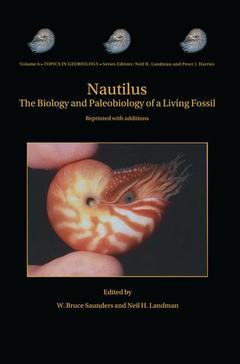Description
Nautilus (2nd Ed., 2nd ed. 2010)
The Biology and Paleobiology of a Living Fossil, Reprint with additions
Topics in Geobiology Series, Vol. 6
Coordinators: Saunders W. Bruce, Landman Neil
Language: English
Subjects for Nautilus:
Keywords
Biome; Ecology; Fauna; evolution; evolutionary biology; phylogeny; physiology
Publication date: 10-2016
Support: Print on demand
Publication date: 12-2009
632 p. · 15.5x23.5 cm · Hardback
Description
/li>Contents
/li>Biography
/li>Comment
/li>
W. Bruce Saunders is Professor, Department of Geology, Bryn Mawr College. He has studied Nautilus for over 30 years, including field work in the Indo-Pacific, especially Palau and Papua New Guinea. He has worked on the ecology, habitat, and life history of Nautilus, and discovered the first living populations of Allonautilus scrobiculatus.
Neil H. Landman is Curator, Division of Paleontology (Invertebrates), American Museum of Natural History. He is an expert on shelled cephalopods including Nautilus and ammonites and the co-editor of the books Cephalopods Present and Past—New Insights and Fresh Perspectives (2007), and Ammonite Paleobiology (1996), both published by Springer.
These books may interest you

Ammonoid Paleobiology 316.49 €



